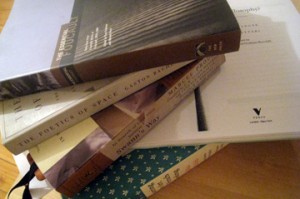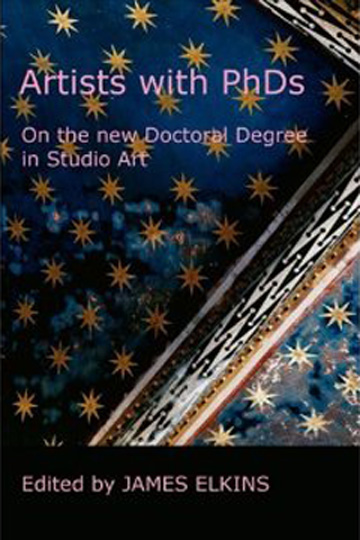After reading my fellow blogger Oliver Wunsch’s interview with George Smith, the founder of the Institute for Doctoral Studies in Visual Arts (IDSVA), I began thinking about a PhD in Visual Culture, especially knowing that in few months I’ll be wrapping up my MFA. I’m still looking for ways in which I can make my post-MFA life practical. So I’ve been looking at my options, studying and researching them. One of the ideas that I’m currently entertaining is the pursuit of the doctorate degree where I can get feasible support from SSHRC (Social Sciences and Humanities Research Council), which offers Canadian candidates fellowships between $5,000 to $35,000 that is renewable per annum to research and create. This doesn’t sound like such a bad idea to be funded to go to school, considering the economy is still perturbed and finding meaningful work in the art world is not easy. Plus, Canada has two relatively new programs at York University and University of Western Ontario that bring together a studio practice with a theoretical component, which sounds ideal for someone like myself who writes and makes things. However, I remain hesitant about this subject matter, because I keep asking myself whether I am willing to commit to another four to five years of school? I’m certain that a PhD might make me into a more well-rounded human being, but what about experiencing the art world from a first person point of view? In this increasingly economically driven culture what will a PhD do for me? Do I need a PhD to be a better artist?
The recent publication of the book, Artists with PhDs: On the New Doctoral Degree in Studio Art; EARN (European Artistic Research Network); Manifesta 8; Collaborative Project: As the Academy Turns, a soap opera about the “academization” of art education; it is clear that there is a growing concern with regards to the changing identity of an artist. The instigation of PhD programs marks a transformation of what was originally an exploratory artistic practice into a more theoretical and research-based model, which closely mimics a scientific methodology, largely founded on hypotheses and answers that need to be validated through reason, testing, and the collection of evidence. However, the making of contemporary art has never been about one absolute answer, rather, an investigation of many ideas and concepts and using suitable materials to articulate these ideas. There have never been straight answers or easy ones, giving artists reasons to constantly push boundaries, looking at the world from different angles. Art after Duchamp was everything and anything. How will having a PhD change that? Who will these new artists with PhDs be? Who will these new artists be making art for? The public? The private? The commercial? Or the educational system? How will they divide their time between making things, writing, and publishing — justifying their work within the framework of critical theory, art history, philosophy, literature, and every attainable interdisciplinary subject matter applicable.
 Truthfully, we no longer live in Oscar Wilde’s time where we can make “art for art’s sake,” especially not in an art institution. Perhaps an MFA is not that different than a PhD, considering every piece of work that an MFA student produces has to congeal to some sort of critical thinking. Just recently, I found myself sitting with Gaston Bachelard, Michel Foucault, Gilles Deleuze and Felix Guattari, Marcel Proust, and even the odd Mastering the Art of French Cooking, with each book blatantly staring at me as I incongruously tried to hammer out an artist’s statement. The artist statement is an essentially personal manifesto, the blending of your current artwork with ideological concepts. It may be the hardest piece of writing that an artist has to do because we have to look within our belief system in an honest and sincere way, while trying to articulate our views of the world using the language within the academic milieu. There are days where I keep asking myself why do I have to continuously justify my work with ideas that belong to someone else? Especially with the works of scholars who have died how many years before I was born? Truthfully, I have mixed feelings about what I write; sometimes it no longer sounds like me and I’m just reiterating a Deleuzian idea. How did the simple pleasures of making art become so systematized? Or maybe it always was? At times, I’m tempted to start my statement by saying: I made this because I wanted to and felt like it! However if I say that, I will have to properly quantify it with some post-structural thought. Being a student, it is imperative to establish a balance between who we are as artists and who we are as scholars, to find those little crevasses of happiness that we enjoy when we make things and that we enjoy when we read books.
Truthfully, we no longer live in Oscar Wilde’s time where we can make “art for art’s sake,” especially not in an art institution. Perhaps an MFA is not that different than a PhD, considering every piece of work that an MFA student produces has to congeal to some sort of critical thinking. Just recently, I found myself sitting with Gaston Bachelard, Michel Foucault, Gilles Deleuze and Felix Guattari, Marcel Proust, and even the odd Mastering the Art of French Cooking, with each book blatantly staring at me as I incongruously tried to hammer out an artist’s statement. The artist statement is an essentially personal manifesto, the blending of your current artwork with ideological concepts. It may be the hardest piece of writing that an artist has to do because we have to look within our belief system in an honest and sincere way, while trying to articulate our views of the world using the language within the academic milieu. There are days where I keep asking myself why do I have to continuously justify my work with ideas that belong to someone else? Especially with the works of scholars who have died how many years before I was born? Truthfully, I have mixed feelings about what I write; sometimes it no longer sounds like me and I’m just reiterating a Deleuzian idea. How did the simple pleasures of making art become so systematized? Or maybe it always was? At times, I’m tempted to start my statement by saying: I made this because I wanted to and felt like it! However if I say that, I will have to properly quantify it with some post-structural thought. Being a student, it is imperative to establish a balance between who we are as artists and who we are as scholars, to find those little crevasses of happiness that we enjoy when we make things and that we enjoy when we read books.
Perhaps the PhD was always the next phase for an MFA student, considering the MFA educational pedagogy doesn’t seem to be that different than the one being offered at the PhD level, as it already combines studio work with critical theory. Either way, whether we choose to pursue MFAs or PhDs, Charles Saatchi said that “being a good artist is the toughest job you could pick, and you have to be a little nuts to take it on…” And that is a fact!! Will having a doctorate degree make my life as an artist a little less demanding, less challenging, less crazy, and more practical? I don’t know.






Pingback: Dr. Art | cablegram
Pingback: Arts For Art Sake | Art Journal